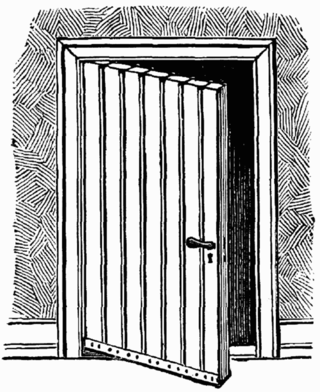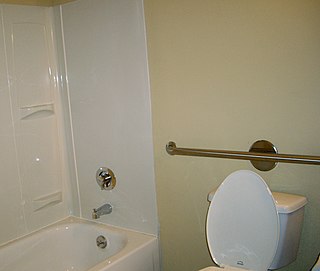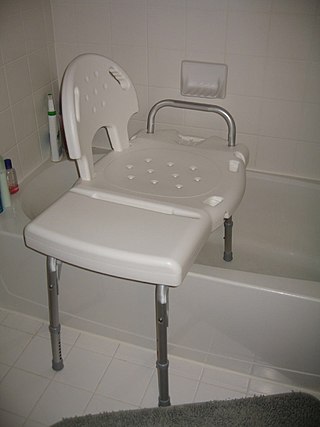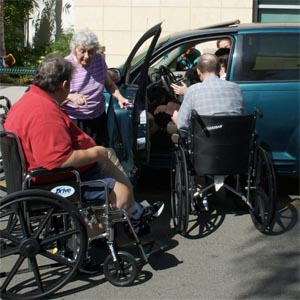
A door is a hinged or otherwise movable barrier that allows ingress (entry) into and egress (exit) from an enclosure. The created opening in the wall is a doorway or portal. A door's essential and primary purpose is to provide security by controlling access to the doorway (portal). Conventionally, it is a panel that fits into the doorway of a building, room, or vehicle. Doors are generally made of a material suited to the door's task. They are commonly attached by hinges, but can move by other means, such as slides or counterbalancing.

A bathroom, restroom or washroom is a room, typically in a home or other residential building, that contains either a bathtub or a shower. The inclusion of a wash basin is common. In parts of the world e.g. India, a toilet is typically included in the bathroom; in others, the toilet is typically given a dedicated room separate from the one allocated for personal hygiene activities. In the United States, the word 'bathroom' is often used to refer to any room that contains a toilet, regardless of the inclusion of a bath or shower.

Accessibility is the design of products, devices, services, vehicles, or environments so as to be usable by people with disabilities. The concept of accessible design and practice of accessible development ensures both "direct access" and "indirect access" meaning compatibility with a person's assistive technology.

A shower is a place in which a person bathes under a spray of typically warm or hot water. Indoors, there is a drain in the floor. Most showers have temperature, spray pressure and adjustable showerhead nozzle. The simplest showers have a swivelling nozzle aiming down on the user, while more complex showers have a showerhead connected to a hose that has a mounting bracket. This allows the showerer to hold the showerhead by hand to spray the water onto different parts of their body. A shower can be installed in a small shower stall or bathtub with a plastic shower curtain or door. Showering is common due to the efficiency of using it compared with a bathtub. Its use in hygiene is, therefore, common practice.

A bathtub, also known simply as a bath or tub, is a container for holding water in which a person or another animal may bathe. Most modern bathtubs are made of thermoformed acrylic, porcelain-enameled steel or cast iron, or fiberglass-reinforced polyester. A bathtub is placed in a bathroom, either as a stand-alone fixture or in conjunction with a shower.

A mobility scooter is an electric personal transporter used as mobility aid for people with physical impairment, mostly auxiliary to a powered wheelchair but configured like a motorscooter. When motorized they function micromobility devices and are commonly referred to as a powered vehicle/scooter, or electric scooter. Non-motorized mobility scooters are less common, but are intended for the estimated 60% of wheelchair users who have at least some use of their legs. Whilst leg issues are commonly assumed to be the reason for using scooters, the vehicles are used by those with a wide range of conditions from spinal injuries to neurological disorders.

A wheelchair-accessible van is a vehicle that has been modified by increasing the interior size of the vehicle and equipping it with a means of wheelchair entry, such as a wheelchair ramp or powered lift.
Visitability is the design approach for new housing such that anyone who uses a wheelchair or other mobility device should be able to visit. A social visit requires the ability to get into the house, to pass through interior doorways, and enter a bathroom to use the toilet. Visitability stresses specific accessibility features from a social reform perspective, and counters social isolation.

Grab bars are safety devices designed to enable a person to maintain balance, lessen fatigue while standing, hold some of their weight while maneuvering, or have something to grab onto in case of a slip or fall. A caregiver may use a grab bar to assist with transferring a patient from one place to another. A worker may use a grab bar to hold on to as he or she climbs, or in case of a fall.
A range of small vehicles have been produced by various manufacturers since the 1950s that have been specifically designed to be driven by a wheelchair user, without the need for the user to transfer from the wheelchair. This distinguishes them from the majority of adapted cars, which are designed to be driven from a conventional driver's seat, whether the driver is a wheelchair user or otherwise impaired. They can be considered a sub-class of wheelchair accessible vehicles, which are predominantly converted mass-production models.

Accessible toilets are toilets that have been specially designed to better accommodate people with physical disabilities. Persons with reduced mobility find them useful, as do those with weak legs, as a higher toilet bowl makes it easier for them to stand up. Additional measures that can be taken to add accessibility to a toilet include providing more space, adding grab bars to ease transfer to and from the toilet seat, and providing extra room for a caregiver if necessary. Some countries have requirements concerning the accessibility of public toilets. Toilets in private homes can be modified (retrofitted) to increase accessibility.

A wheelchair lift, also known as a platform lift, or vertical platform lift, is a fully powered device designed to raise a wheelchair and its occupant in order to overcome a step or similar vertical barrier.

A mobility aid is a device designed to assist walking or otherwise improve the mobility of people with a mobility impairment.

A transfer bench is a bath safety mobility device on which the user sits to get into a bathtub. The user usually sits on the bench, which straddles the side of the tub, and gradually slides from the outside to the inside of the tub. Tub transfer benches are used by people who have trouble getting over the tub wall or into the shower, either because of illness or disability.

A wheelchair is a mobilized form of chair using 2 or more wheels, a footrest and armrest usually cushioned. It is used when walking is difficult or impossible to do due to illnesses, injury, disabilities, or age related health conditions.

A shower splash guard is a permanently installed, fixed, rigid fitting made of plastic or glass that prevent water from a shower from splashing out of the bathtub and onto the floor. Typically, the shower splash guard is a small triangular piece of plastic that is used in combination with a shower curtain, to prevent water escaping at the corners, but it may be a much larger piece that is used by itself.
Bus doors are of various types of buses with doors including conventional doors, folding doors, sliding plug doors, coach doors and inward gliding doors.
Accessible housing refers to the construction or modification of housing to enable independent living for persons with disabilities. Accessibility is achieved through architectural design, but also by integrating accessibility features such as modified furniture, shelves and cupboards, or even electronic devices in the home.

The European Union Persons with Reduced Mobility (PRM) legislation is intended to ensure that Persons with Reduced Mobility (whether disabled, elderly or otherwise) traveling via public transport, whether by air, land or sea, should have equal access to travel as compared to travelers with unrestricted mobility. Travel providers are compelled to provide and install sufficient access facilities to enable Passenger with Reduced Mobility to enjoy similar access to other passengers (where feasible and with certain safety exemptions).

An adapted automobile is an automobile adapted for ease of use by people with disabilities. Automobiles, whether cars or vans, can be adapted for a range of physical disabilities.
















